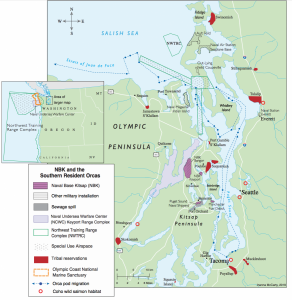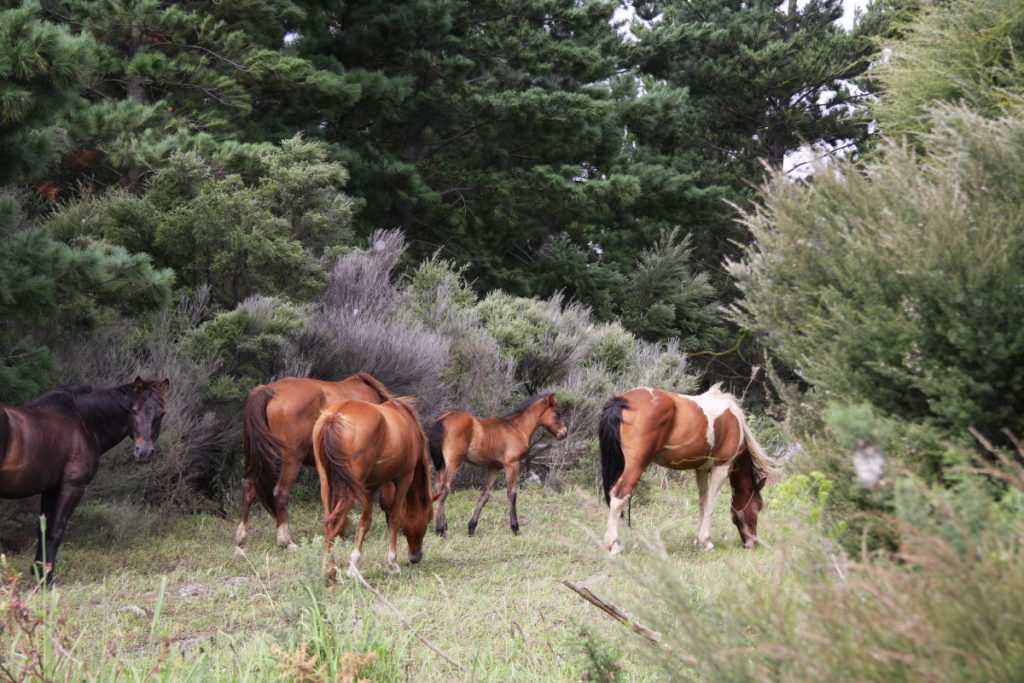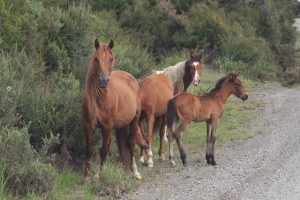
Inanna McCarty
This is my map of the naval bases of western washington, including Naval Base Kitsap (NBK) and Naval Air Station Whidbey Island (NASWI). The map includes the bases’ training facilities, reserved underwater training area, and special use airspace. The map also includes the Naval Magazine Indian Island, where weapons are shipped to overseas war zones, and the 2018 sewage spill at the Puget Sound Naval Shipyard.
My map highlights Orca whale pods, migration routes, and their “hang-out” spots in the Salish Sea. I wanted to illustrate with this map not only where the bases are located, but the significant overlap between NBK training areas and the migration routes of the Orca pods (specifically the Southern Resident Killer Whale pods) .
In a 2009 Biological Evaluation report by the Northwest Training Range Complex, a map shows the Orcas’ seasonal occupied water regions. Within those regions are the designated areas used for naval underwater training, underwater missile firing, and usage of sonar. As the Orcas make their way further up north, they come into the Northwest Training Range Complex, which the Navy does not consider critical Orca habitat.
Orca’s dominant communication frequencies range from 20 to 60 kilohertz (kHz). The 2009 Biological Evaluation tells of the active usage of sonar in the NWTRC. The MK-48 (torpedo sonar), which is categorized as in a high-frequency class, is to be used twice a year. The AN/BGS-15 (submarine mine sonar), which is also classified as high-frequency is used for 42 hours annually. The AN/BGS-15 is for small-scale underwater training in submarine mine avoidance. An underwater minefield consists of 15 mine- shaped devices attached to the ocean floor at depth of 500-600 feet. (Such an inert mine was found floating near Port Orchard in August 2018.) The NWTRC will use one submarine using AN/BGS-15 sonar for six hours to do navigational training through the minefield. Seven mine avoidance exercises are to occur in the NWTRC annually.
These underwater training areas are in the pathway of the Southern Resident Orca pods. The sonar frequencies that the NWTRC is using are of abrasive high frequencies. This causes disruption of communication between the Orcas, and could cause the Orca calves to stray from their mothers and become lost from their pod.
In July 2020, the naval testing program “that appeared headed to routine approval has hit a wall of opposition from Washington’s governor, attorney general and state agencies because of potential harm to endangered orcas in Washington waters” (Mapes 2020).
But the program was approved in November 2020 to “increase the potential ‘take’ of Southern Resident orcas — ‘take’ means the attempted or actual harassment, hunting, capturing or killing of any marine mammal. Currently, the Navy is authorized to take up to two Southern Resident orcas per year, but the new rule will allow it to take up to 51 orcas per year until 2027. The testing and training involves various activities, including firing torpedoes and projectiles, detonating bombs, piloting undersea drones and using sonar. The increase in the number of takes comes after Naval studies showed the population of Southern Resident killer whales in the sound was far denser than previous models showed” (Shull 2020).
Sources
Dunagan, C. (2018, February 28). Can carefully planned fishing seasons help the endangered orcas? Kitsap Sun.
Dunagan, C. (2016, March 12). Environmental Groups will Boycott Navy Meetings. Kitsap Sun.
FOX Q-13 News. (2018, September 09). Long-running sewage spill discovered at Naval Base Kitsap. FOX Q-13.
KOMO Staff. (2018, August 28). Navy safely detonates decades-old mine found floating in Port Orchard Bay. KOMO News.
Mapes, Linda. (2020, July 29). Washington state officials slam Navy’s changes to military testing program that would harm more orcas. Seattle Times.
National Oceanic and Atmospheric Administration (NOAA). (2014, January 29). 2014 Southern Resident Killer Whale Satellite Tagging. NOAA.
Northwest Training Range Complex. (2009). Rep. No. Northwest Training Range Complex Marine and Terrestrial Species Biological Evaluation at 18-66. U.S. Navy.
Shull, Abbie. (2020, November 10). Navy Receives Approval for Exercises that Could Increase Harm to Washington Orcas. Military.com.
Washington Department of Fish and Wildlife. (2011). Puget Sound/Hood Canal Salmon Recovery Regions. WDFW Conservation.


